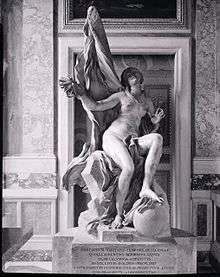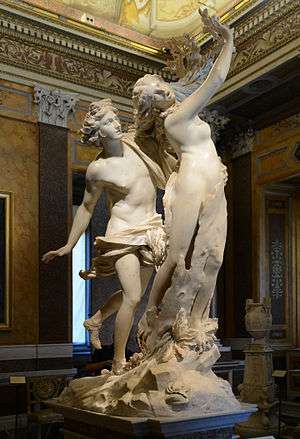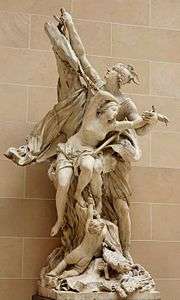Baroque sculpture
Baroque sculpture is the sculpture associated with the Baroque cultural movement. In Baroque sculpture, groups of figures assumed new importance, and there was a dynamic movement and energy of human forms— they spiralled around an empty central vortex, or reached outwards into the surrounding space. Baroque sculpture often had multiple ideal viewing angles, and reflected a general continuation of the Renaissance move away from the relief to sculpture created in the round, and designed to be placed in the middle of a large space – elaborate fountains such as Bernini's Fontana dei Quattro Fiumi (Rome, 1651), or those in the Gardens of Versailles were a Baroque speciality. The Baroque style was perfectly suited to sculpture, with Gian Lorenzo Bernini the dominating figure of the age in works such as The Ecstasy of St Theresa (1647–1652).[1] Much Baroque sculpture added extra-sculptural elements, for example, concealed lighting, or water fountains, or fused sculpture and architecture to create a transformative experience for the viewer. Artists saw themselves as in the classical tradition, but admired Hellenistic and later Roman sculpture, rather than that of the more "Classical" periods as they are seen today.[2]
Course

The Protestant Reformation brought an almost total stop to religious sculpture in much of Northern Europe, and though secular sculpture, especially for portrait busts and tomb monuments, continued, the Dutch Golden Age has no significant sculptural component outside goldsmithing.[3] Partly in direct reaction, sculpture was as prominent in Catholicism as in the late Middle Ages. Statues of rulers and the nobility became increasingly popular. In the 18th century much sculpture continued on Baroque lines – the Trevi Fountain was only completed in 1762. The Rococo style was better suited to smaller works.[4] Aleijadinho in Brazil was also one of the great names of baroque sculpture, and his master work is the set of statues of the Santuário de Bom Jesus de Matosinhos in Congonhas. The soapstone sculptures of old testament prophets around the terrace are considered amongst his finest work.
The architecture, sculpture and fountains of Bernini (1598–1680) give highly charged characteristics of Baroque style. Bernini was undoubtedly the most important sculptor of the Baroque period. He approached Michelangelo in his omnicompetence: Bernini sculpted, worked as an architect, painted, wrote plays, and staged spectacles. In the late 20th century Bernini was most valued for his sculpture, both for his virtuosity in carving marble and his ability to create figures that combine the physical and the spiritual. He was also a fine sculptor of bust portraits in high demand among the powerful. Bernini died in 1680 but his heritage was absorbed by sculptors painters and architects in their work in the first half of the 18th century particularly in Bavaria, France and Austria.
-

Gian Lorenzo Bernini, Apollo and Daphne in the Galleria Borghese, 1622–1625
-

Bust of Louis XIV, 1686, by Antoine Coysevox
-

Pierre Paul Puget, Perseus and Andromeda, 1715, Musée du Louvre
Baroque sculptors
- Aleijadinho
- Alessandro Algardi
- Gian Lorenzo Bernini
- Francesco Borromini
- Matthias Braun
- Ferdinand Maxmilián Brokoff
- Nicolas Coustou
- Antoine Coysevox
- François Duquesnoy
- Gregorio Fernández
- Ignaz Günther
- Pierre Legros
- Juan Martínez Montañés
- Pedro de Mena
- Juan de Mesa
- Pierre Puget
- Artus Quellinus the Elder
- Artus Quellinus the Younger
- Egid Quirin Asam
- Camillo Rusconi
- Johann Baptist Straub
- Rombout Verhulst
- Hendrik Frans Verbrugghen
Notes
- ↑ Boucher, 134-142 on the Cornaro chapel; see index for Bernini generally
- ↑ Boucher, 16–18
- ↑ Honour and Fleming, 450
- ↑ Honour and Fleming, 460-467
References
| Wikimedia Commons has media related to Baroque sculptures. |
- Boucher, Bruce, Italian Baroque Sculpture, 1998, Thames & Hudson (World of Art), ISBN 0500203075
- Hugh Honour and John Fleming, A World History of Art, 1st edn. 1982 (many later editions), Macmillan, London, page refs to 1984 Macmillan 1st edn. paperback. ISBN 0333371852